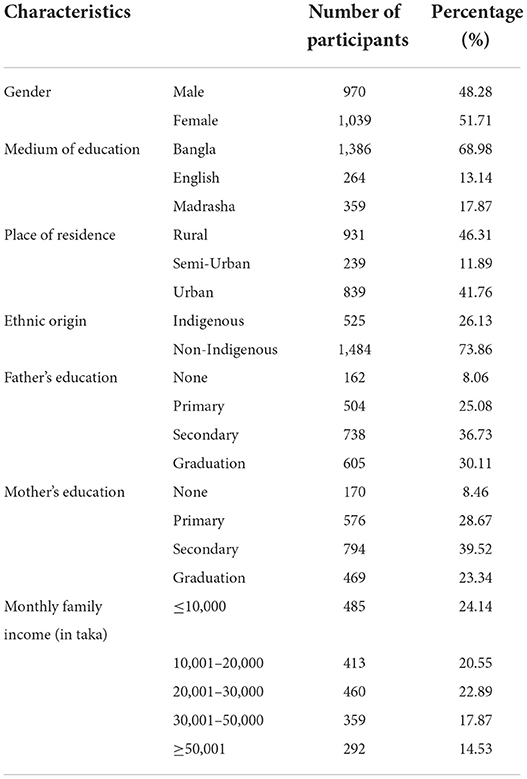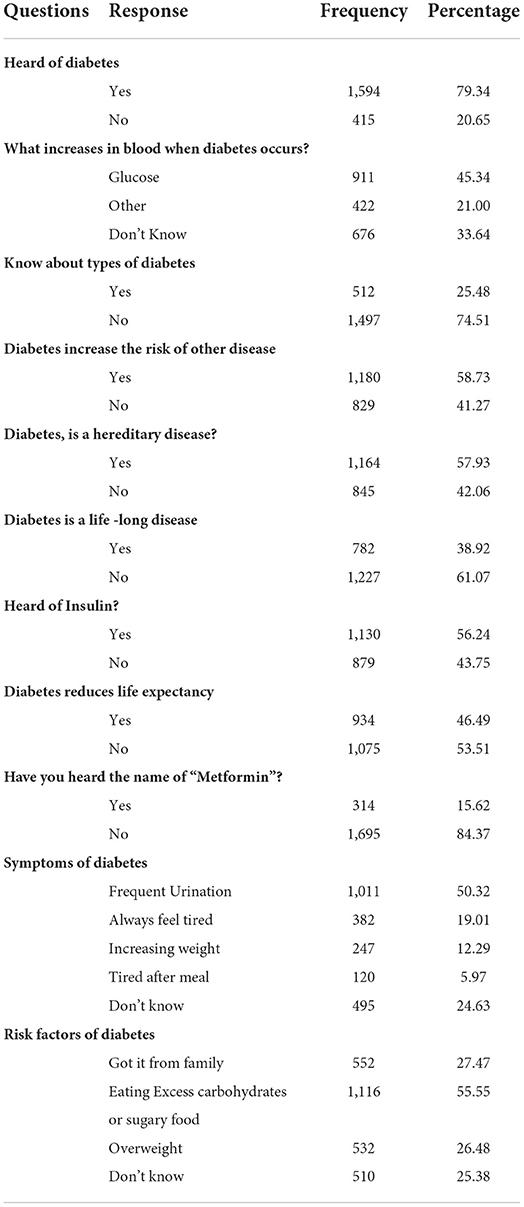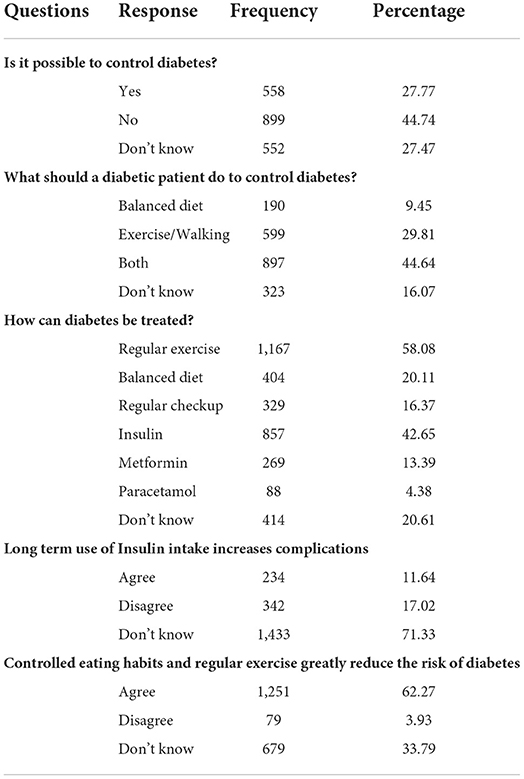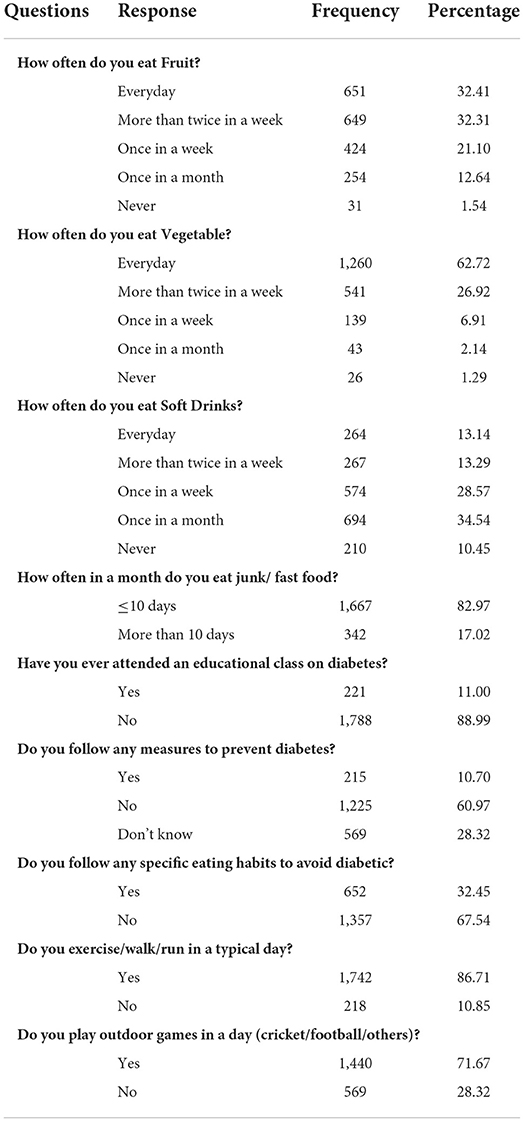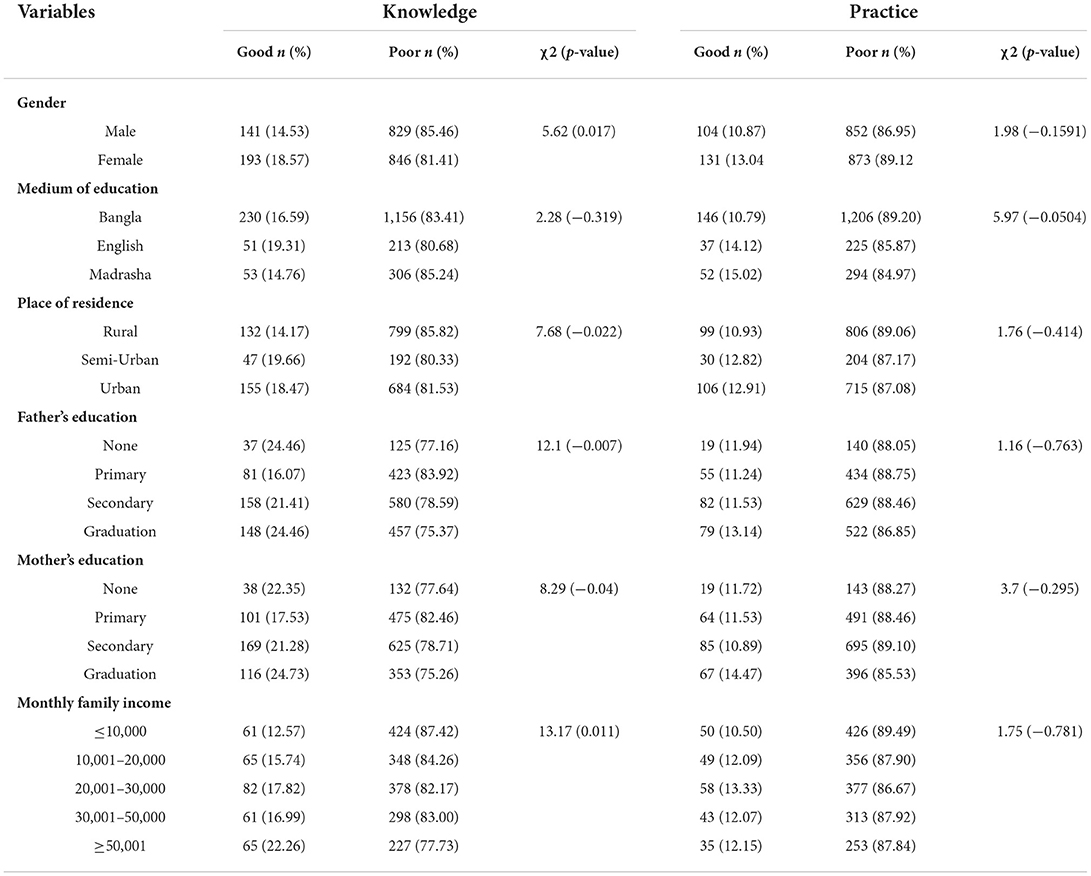- 1Department of Endocrinology, Chittagong Medical College, Chattogram, Bangladesh
- 2Disease Biology & Molecular Epidemiology Research Group, Chattogram, Bangladesh
- 3Department of Genetic Engineering & Biotechnology, University of Dhaka, Dhaka, Bangladesh
- 4Department of Public Health, Asian University for Women, Chittagong, Bangladesh
- 5Institute of Statistical Research and Training, University of Dhaka, Dhaka, Bangladesh
- 6Department of Epidemiology, Institute of Epidemiology, Disease Control & Research (IEDCR), Dhaka, Bangladesh
- 7Department of Genetic Engineering & Biotechnology, University of Chittagong, Chattogram, Bangladesh
Diabetes Mellitus (DM) is a global public health concern. DM has been increasing alarmingly among the young people and childhood-onset has now become an emerging issue worldwide. Unlike other chronic diseases, DM requires constant and active attention of the patients, sometimes of their family members for successful management of this disease. Knowledge, attitude, and practices make significant differences at the population level, which largely depend on socioeconomic status, area of residence, level of education, and other socio-demographic attributes. A descriptive cross-sectional study was carried out among secondary school students in grades 6 through 10 attending schools in 18 districts of Bangladesh. A total of 2009 students were enrolled for the study from the selected schools and madrasas from Bengali, English, and Arabic medium. The majority of responders (79.34%) reported that they had heard of diabetes, however, only 45% knew that diabetes can cause blood glucose levels to rise. Among different therapeutic options, only 15% of students had heard the name of metformin, while 56.2% were familiar with insulin. English medium students were significantly more likely to have good knowledge than the Bangla medium students (19.31%, OR: 1. 44; 95% CI: 1.07, 1.95). Respondents of semi-urban (19.66%, OR: 1.7; 95% CI: 1.21, 2.36) and urban (18.47%, OR: 1.48; 95% CI: 1.17, 1.86) areas were more likely to have good knowledge than rural areas. Of the respondents, 20.61% did not know of any diabetic treatment options. Only a small percentage of students (11%) attended any diabetes education classes and 10.7% of students followed any recommended diabetes prevention methods. Knowledge, attitude, and practice related to diabetes were found to have been influenced by socioeconomic factors, societal practices, and behavioral patterns. This is the first nationwide research study in Bangladesh among secondary school students to study knowledge, attitudes, and practices related to diabetes. With a focus on Bangladesh's youthful population, this study sought to provide an informational framework that can be supportive for effective intervention to increase knowledge of diabetes and its implications.
Introduction
Diabetes Mellitus (DM) is one of the major non-communicable diseases that has a significant association with increasing morbidity and mortality globally (1). According to the World Health Organization, DM is a silent global epidemic affecting mainly older adults; however, DM among the young population has been increasing consistently (1, 2). The prevalence of DM has been rising more rapidly in low- and middle-income countries than in high-income countries (1, 3, 4). Approximately 537 million adults (20–79 years) live with diabetes; and by 2045, this will rise to 783 million (1). The International Diabetes Federation estimated about 13.1 million people have diabetes in Bangladesh with a prevalence of 14.2% in adults and almost 5.7 million people have undetectable diabetes (5). The number is suspected to be doubled by 2045. Moreover, the prevalence of type-2 diabetes is increasing at an alarming rate among adults in both the rural and urban settings of the country (6, 7).
Besides adult Diabetes, childhood-onset DM has now become a burning issue worldwide (8–10). A recently published study conducted on US youths aged 10 to 19 showed that 22.3 and 13.8 per 100,000 youths were affected with Type 1 and Type 2 diabetes, respectively, in 2015 (8). The rates of incident diabetes cases have been increasing by about 1.9% for type 1 diabetes (T1DM) and 4.8% for type 2 diabetes (T2DM). Asian youths have shown the highest rate of increased prevalence of T2DM. The prevalence of impaired fasting glucose and type 2 diabetes among Bangladeshi youths aged 10–18 is 3.4 and 1.8%, respectively, which can be considered as very high (11).
Several factors have been attributed to the rising prevalence of diabetes including urbanization, adopting a western lifestyle, inadequate physical activity, and excess calorie intake (12). Both micro and macrovascular complications like cardiovascular diseases, retinopathy, nephropathy, and neuropathy have been known as long-term consequences of DM (13). This will significantly deteriorate patients' quality of life and creates a significant financial burden at the national and individual level. Prevention and self-care are the cornerstones of diabetes management as evidenced by various studies and populations (14–16). Unlike other chronic diseases, DM requires the constant, active participation of the patients, sometimes of their family members for successful management of this disease (15). Several studies have reported that knowledge, attitude, and practices at the population level that make significant differences largely depend on socioeconomic status, residing area, level of education, and other socio-demographic attributes (17, 18). Knowledge of diabetes mellitus at an early stage of life can assist in early diagnosis with subsequent minimizing of diabetes-related life-threatening complications (19–23). So, to prevent the upward trend of increasing young diabetic patients, it is necessary to know how much awareness has been built among people, especially children about different factors like lifestyle modification, dietary readjustment, treatment, medication adherence, physical activity, etc. Lack of appropriate perception about the disease results in poor compliance. However, this type of study has not been done yet on school-going children in Bangladesh. To build a strategy to create awareness, it is important to know to what extent the young people of this country are concerned about these health issues.
This is the first nationwide research study in Bangladesh among secondary school students to evaluate knowledge, attitudes, and practices related to diabetes. This study aimed to help guide effective intervention to raise awareness about diabetes and its consequences, especially among the young generation in Bangladesh, and contribute to much-needed healthy lifestyle adoption.
Materials and methods
Study design, participants and settings
Between January 2021 and January 2022, a descriptive cross-sectional study was carried out among high school students in grades 6 through 10 attending schools from Bengali, English and Arabic medium. For a better understanding of the real KAP scenarios of DM and geographic representation of Bangladesh, a total of 18 districts, drawn from all 8 administrative divisions of Bangladesh: Dhaka, Chattogram, Sylhet, Khulna, Rajshahi, Mymensingh, Barisal, and Rangpur were included in the study. A total of 18 districts were selected purposively, eight administrative districts of all divisions, top 7 densely populated districts to represent densely populated districts from census data and 3 indigenous districts were chosen to represent the indigenous population and hill tracts area. Using census data from the Bangladesh Bureau of Statistics (BBS) and nine of the education boards of Bangladesh, a total of 78 schools and madrasa were selected randomly from a list of all eligible and currently functioning schools. The schools and madrasas having the highest number of students from each district were selected. Selected schools follow both Bangla and English medium curricula while madrasas follow Arabic curriculum. English medium schools are mostly private, and students studying there mostly belong to the economically well-off families. A total of 2009 students were enrolled for the study from the selected schools and madrasas, ranging in grade level from sixth to tenth.
Data collection procedure and tools
A pre-tested, structured close-ended questionnaire was used for data collection. The questionnaire consisted of five sections: socio-demographic characteristics; lifestyle-related practices; knowledge of diabetes, attitude toward diabetes, and practices on diabetes issues. The knowledge, attitude and practice level of the students were assessed based on the lifestyle modification/behavioral risk factors/choices of diabetes management included in the questionnaire. A semi-structured questionnaire was used to collect data by face-to-face interviews with trained interviewers having study background on life science or public health. This included family status, obesity, anxiety, salt intake, lack of exercise and physical activity, high fat diet, use of soft drinks, fast food consumption, symptoms of diabetes, and treatment of diabetes. The questionnaire was developed with input from study investigators with specialties in the field of epidemiology, endocrinology, public health and pediatrics. A pilot testing of the questionnaire was conducted among the children of Noakhali and Manikgonj district, the districts not included the main study. Feedback from pilot test has been incorporated for finalization of the questionnaire.
After informing and obtaining written permission from the school authorities and legal guardians, the purpose of the study was explained to the students. Parental assent was taken after explaining the study objectives and purpose of the study. The study tool was converted into the Bengali language for easy understanding of the questions. Anonymity and confidentiality were highly maintained. The collected data were entered into an excel spreadsheet.
Statistical analysis
Survey data was imported through Microsoft Excel and analyzed via R version 3.5.2. Knowledge, attitude, and practice scores of the respondents were calculated from 15 knowledge questions, 6 attitude questions, and 9 practice questions. Scores were estimated using a score of 1 for each right answer and 0 for each wrong answer. Maximum score of knowledge, attitude and practice was 13, 6, and 8, respectively. Correct answer to 80% of questions is considered as the cutoff point to differentiate between good and poor knowledge, positive and negative attitude, good and bad practice (24).
Descriptive statistics were employed to describe socio demographic characteristics of the respondents and to demonstrate students' knowledge, attitude and practice toward diabetes. Pearson chi-square test was used to test the association of socio-demographic characteristics with the knowledge and practice status of the students. Multiple logistic regression analyses were done to estimate univariate and multivariable Odds ratio and 95% confidence interval to determine the predictors of knowledge level, where dependent variables were dichotomized as Good Knowledge and Poor Knowledge and predictor variables included socio-demographic variables including age, gender, medium of education, family income and father's and mother's education.
Results
Socio-demographics
In total, 2009 students took part in the survey; 970 of them (48.28%) were boys and 1,039 (51.71%) were girls. Bangla was the language of instruction for the majority of students (68.98%), followed by Madrasha (17.87%) and English (13.14). The survey covered 26.13% indigenous and 73% non-indigenous students. In comparison to rural (46.31%) and urban (41.76%) areas, a smaller share (11.89%) of the sample population came from semi-urban areas. Most study participants had a family income of ≤100 USD per month. In terms of their parents' education, the majority had only completed primary school (Table 1).
Knowledge
The majority of responders (79.34%) reported that they had heard of diabetes, however, only 45% knew that diabetes can cause blood glucose levels to rise. Only 15% of students had heard the name of metformin, while 56.2% were familiar with insulin. A whopping 58% of students believed that diabetes was a hereditary condition and 46.49% of students thought that it could reduce life expectancy (Table 2).
In multiple response analysis, 24.63% of respondents did not know any symptoms of diabetes, whereas 50.32% of respondents reported that frequent urination might be a sign of diabetes and 19.01% answered feeling tired all the time as a symptom. Regarding the risk factors for diabetes, 27.47% of respondents reported that the disease could occur from family heredity. Overconsumption of carbs or sugary meals can raise the risk of diabetes reported by 55.55% of the participants. Furthermore, being overweight was cited as a risk factor for diabetes by 26.48% of students, while 25.38% reported that they were unaware of any diabetes risk factors.
Overall, a higher proportion of girls were found to have good knowledge of diabetes than boys (18.57% vs. 14.53%). Interestingly, the difference in knowledge status is insignificant between mediums of education. Conversely, there were statistically significant differences in knowledge level by place of residence, ethnicity and monthly family income (Table 3).
From the logistic regression analysis, we found that for 1 year change of age there were no significant changes in students' knowledge level regarding diabetes. English medium students were significantly more likely to have good knowledge than the Bangla medium students (19.31%, OR: 1. 44; CI: 1.07, 1.95). Respondent's place of residence was significantly associated with their knowledge regarding diabetes. Respondents of semi-urban (19.66%, OR: 1.7; CI: 1.21, 2.36) and urban (18.47%, OR: 1.48; CI: 1.17, 1.86) areas were more likely to have good knowledge than rural areas. Monthly family income level had a significant effect on students' knowledge. The likelihood of having good knowledge was more among students whose monthly family income was more than 500 USD. After adjusting for known covariates and confounding factors, we found no significant association between demographic characteristics and student knowledge about diabetes except the student's place of residence. Students of semi-urban areas were more likely to have good knowledge than those in rural areas (19.66%, OR: 1.62; CI: 1.14, 2.31) (Table 4).
Attitude
All about 28% of respondents reported that it might be possible to control diabetes; 62.27% of them reported controlled diet and regular exercise significantly lower the chance of developing diabetes (Table 5). A frequent checkup is important for managing diabetes as reported by 16.37% of the students and 20.61% of students did not know of any diabetic treatment options. Of the participants, 42.65% reported that insulin could treat diabetes, while the majority of students (71.33%) were unaware that long-term insulin use could raise difficulties.
Practice
To prevent diabetes, 32.41% of students reported that they eat fruits every day (Table 6). Most of the students reported doing physical activities daily (86.71%) and playing outdoor games (71.67%). Only a small percentage of students (11%) attended any diabetes education classes and 10.7% of students followed any recommended diabetes prevention methods.
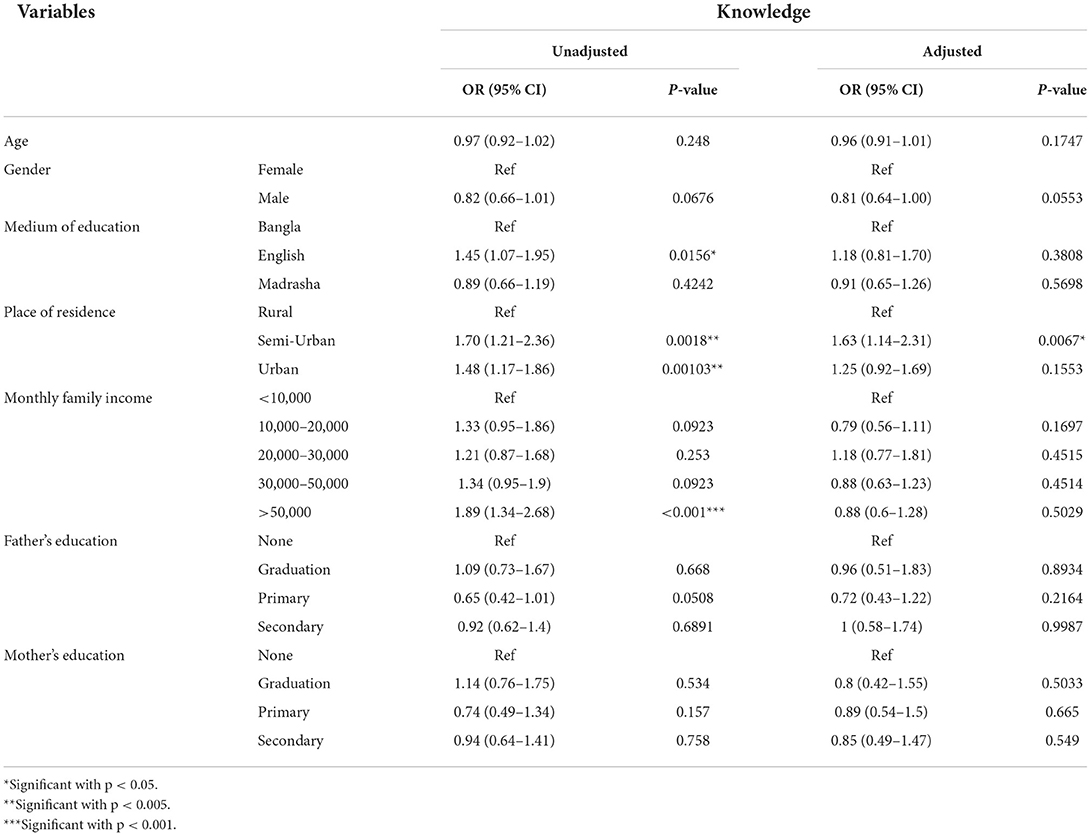
Table 6. Results of multiple logistic regression on factors determining level of diabetes knowledge.
Practices related to diabetes prevention were not found to be significantly different by gender, parents' educational levels, or place of living.
Determinants of diabetes knowledge
It was found from logistic regression analysis that age was not a significant predictor of students' knowledge level regarding diabetes (Table 4). English medium students were significantly more likely to have good knowledge than the Bangla medium students (19.31%, OR: 1. 44; CI: 1.07, 1.95) as found from an unadjusted model; however, this finishing was not significant after adjustment with covariates. Respondent's place of residence was significantly associated with their knowledge regarding diabetes. Respondents from semi-urban areas (19.66%, OR: 1.7; CI: 1.21, 2.36) and urban (18.47%, OR: 1.48; CI: 1.17, 1.86) areas were more likely to have good knowledge than those living in rural areas. Monthly family income level had a significant effect on students' knowledge. The likelihood of having good knowledge was more among students whose monthly family income was more than USD 500, however, after adjusting for known covariates and confounding factors, we found no significant association between demographic characteristics and student knowledge about diabetes except for students' place of residence. Students of the semi-urban areas were more likely to have good knowledge than rural areas (Adjusted OR: 1.63; CI: 1.14–2.31).
Discussion
This study aimed to study knowledge, attitudes and practices related to diabetes among secondary school students. Our findings revealed that a large proportion of students have overall poor knowledge and low awareness about diabetes, which is a major health issue of our time. This study included young population of diverse socio-demographic background to include indigenous students and others who opted for the private English medium schools. It was also highlighted that our school education systems rarely focus on heath literacy as it was found that only a small percentage of students' reporting having had attended session diabetes. Due to the rapid increase of diabetes cases worldwide; primary prevention, early diagnosis, and educational preventive measures are now being prioritized (13). It is suggested that the management of such health issues has been shown to be benefited greatly from people's education (17). Understanding diabetes and increasing general population awareness of the condition at a young age can help with early identification which ultimately can lessen life-threatening consequences that are linked to the disease (19, 20).
Overall participation rate was good in this study and the male-female ratio of the participants represents the current population scenario of Bangladesh (25). The study finds an average to low level of understanding of DM among young students in Bangladesh. While most of the participants knew about diabetes as a disease, but only half of them knew about the association of glucose and insulin with diabetes. Nearly half of the students were found to have awareness of the negative effect of taking excess carbohydrates in their meals, however, only one-fourth of the participants were able to recognize the association of obesity with diabetes which is very low compared to the findings of studies conducted on adolescents of Kuwait and Nigeria (12, 20). This finding might coincide with the fact that diabetes in the adult population in Bangladesh who are also obese or overweight has been reported to be high (26, 27).
In general, the school children exhibited poor knowledge of the signs and symptoms of diabetes, for example, only half of the participants knew excessive thirst and increased urination as a sign of diabetes. A similar knowledge pattern was observed in Nigerian adolescents but young students in Kuwait were found quite aware of the diabetes symptoms (12, 20). The fact that young students have such a limited understanding of the signs and symptoms of diabetes needs further attention, as early detection of the condition and fast treatment are both possible with early awareness of the symptoms (24–26).
It is rather concerning that nearly about three-fourths of participants were not aware that diabetes can be controlled through physical exercise, regulated diet intake and recommended medication including insulin when needed, which is very low in contrast with another study (23).
The study identified inadequate awareness programs running in the country that can contribute to raising awareness of diabetes and its associated management system, particularly among the young population in Bangladesh. Only 11% of the participants reported attending any educational programs on diabetes leaving a huge majority of the participants out of any kind of formal awareness-raising programs that can prevent diabetes in the future. However, the study found a satisfactory level of practices that ultimately can help in reducing the risk of diabetes in the future. About two-thirds of the participants used to have fruits in their meals regularly. Almost a universal level of the participants reported having vegetables in their meals at least twice a week.
Knowledge, attitude, and practice related to diabetes were found to have been influenced by socioeconomic factors, societal practices, and behavioral patterns (20). This study supports the mainstream findings since the regression model suggests that odds of having good knowledge about diabetes was significantly higher among students who belong to high-income families, those who live in urban or semi-urban areas, and studies in schools whose medium of instruction is English. However, this study did not find any significant differences in diabetes-related KAP status by their gender, medium of education, location, parents' education as well as family income.
This study was exclusive in that it focused on students in grades 6 through 10 who were between the ages of 9 and 16 and represented all geographical divisions of Bangladesh, encompassing rural, suburban, and urban areas. The study also includes students of indigenous origin. This is the first study in Bangladesh conducted to date among school children that evaluate the KAP of DM. The study also had a few limitations. Purposive sampling was used for selection of schools and the students as participants. Although the study area covered all eight administrative divisions in Bangladesh and study participants representing diverse socioeconomic status, however, precaution should be practiced for generalizability of the study finding. Data were collected through interview of school children without using particular scale, so collected data may suffer from recall bias or social desirability bias.
Conclusion
The study finds an average to low level of knowledge and awareness of DM among secondary school students in Bangladesh, while most of them knew about diabetes itself but they lack some basic knowledge related to signs and symptoms, prevention and control measures. There was a substantial lack of accessible awareness-raising programs for the young population that may be attributable to overall poor KAP among school children. This study highly recommends initiating large-scale country-wide awareness-raising events where young-age people can participate and acquire knowledge and skills to shape up their plans in fighting chronic diseases like diabetes in the future.
Data availability statement
The raw data supporting the conclusions of this article will be made available by the authors, without undue reservation.
Ethics statement
The studies involving human participants were reviewed and approved by Ethical Review Committee (CMC/PG/2020/122) of Chittagong Medical College, Chattogram, Bangladesh. Written informed consent to participate in this study was provided by the participants' legal guardian/next of kin.
Author contributions
FA, SR, MQ, NA, and AM conceived and designed the experiments. FA and AM coordinated the study. NL, MN, AM, and NA analyzed the data and drafted the manuscript. FA, MQ, MN, NA, and AM revised the manuscript. All authors contributed to the article and approved the submitted version.
Acknowledgments
Authors would like to thank the authority of participating schools and madrashas, Disease Biology and Molecular Epidemiology Research Group (dBme) Chittagong, and Chittagong University Research and Higher Study Society (CURHS) for their support during the study.
Conflict of interest
The authors declare that the research was conducted in the absence of any commercial or financial relationships that could be construed as a potential conflict of interest.
Publisher's note
All claims expressed in this article are solely those of the authors and do not necessarily represent those of their affiliated organizations, or those of the publisher, the editors and the reviewers. Any product that may be evaluated in this article, or claim that may be made by its manufacturer, is not guaranteed or endorsed by the publisher.
References
1. Sun H, Saeedi P, Karuranga S, Pinkepank M, Ogurtsova K, Duncan BB, et al. IDF Diabetes Atlas: global, regional and country-level diabetes prevalence estimates for 2021 and projections for (2045). Diabetes Res Clin Pract. (2022) 183:109119. doi: 10.1016/j.diabres.2021.109119
2. World Health Organization. Diabetes: Key Facts 2020. (2021). Available online at: https://www.who.int/news-room/fact-sheets/detail/diabetes.
3. Ewen M, Joosse H-J, Beran D, Laing R. Insulin prices, availability and affordability in 13 low-income and middle-income countries. BMJ Glob Health. (2019) 4:e001410. doi: 10.1136/bmjgh-2019-001410
4. Haque M, Islam T, Rahman NAA, McKimm J, Abdullah A, Dhingra S. Strengthening primary health-C are services to help prevent and control long-term (chronic) non-communicable diseases in low-and middle-income countries. Risk Manag Healthc Policy. (2020) 13:409. doi: 10.2147/RMHP.S239074
5. Federation ID. IDF Diabetes Atlas Tenth edition. 10. Magliano D, editor. ISBN: 978-2-930229-98-0 (2021). Available online at: https://diabetesatlas.org/atlas/tenth-edition/ (accessed July 19, 2022).
6. Biswas T, Islam A, Rawal L, Islam S. Increasing prevalence of diabetes in Bangladesh: a scoping review. Public Health. (2016) 138:4–11. doi: 10.1016/j.puhe.2016.03.025
7. Talukder A, Hossain M. Prevalence of diabetes mellitus and its associated factors in Bangladesh: application of two-level logistic regression model. Sci Rep. (2020) 10:1–7. doi: 10.1038/s41598-020-66084-9
8. Divers J, Mayer-Davis EJ, Lawrence JM, Isom S, Dabelea D, Dolan L, et al. Trends in incidence of type 1 and type 2 diabetes among youths—selected counties and Indian reservations, United States, 2002–2015. Morbid Mortal Weekly Rep. (2020) 69:161. doi: 10.15585/mmwr.mm6906a3
9. Kao K-T, Islam N, Fox DA, Amed S. Incidence trends of diabetic ketoacidosis in children and adolescents with type 1 diabetes in British Columbia, Canada. J Pediatr. (2020) 221:165–73. e2. doi: 10.1016/j.jpeds.2020.02.069
10. Candler T, Mahmoud O, Lynn R, Majbar A, Barrett T, Shield J. Continuing rise of type 2 diabetes incidence in children and young people in the UK. Diabetic Med. (2018) 35:737–44. doi: 10.1111/dme.13609
11. Sayeed MA, Rahman MM, Fayzunnessa N, Khanam PA, Begum T, Mahtab H, et al. Childhood diabetes in a Bangladeshi population. J Diabetes Mellitus. (2013) 3:33. doi: 10.4236/jdm.2013.31006
12. Unadike B, Chineye S. Knowledge, awareness, and impact of diabetes among adolescents in Uyo, Nigeria. Afr J Diabetes Med. (2009) 3:12–14. Available online at: https://www.africanjournalofdiabetesmedicine.com/abstract/knowledge-awareness-and-impact-of-diabetes-among-adolescents-in-uyo-nigeria-76887.html
13. Mohan D, Raj D, Shanthirani C, Datta M, Unwin N, Kapur A, et al. Awareness and knowledge of diabetes in Chennai-the Chennai urban rural epidemiology study [CURES-9]. J Assoc Phys India. (2005) 53:283–7. Available online at: https://www.japi.org/u28464b4/awareness-and-knowledge-of-diabetes-in-chennai-the-chennai-urban-rural-epidemiology-study-cures-9
14. Chatterjee S, Davies MJ, Heller S, Speight J, Snoek FJ, Khunti K. Diabetes structured self-management education programmes: a narrative review and current innovations. Lancet Diabetes Endocrinol. (2018) 6:130–42. doi: 10.1016/S2213-8587(17)30239-5
15. Ross J, Stevenson FA, Dack C, Pal K, May CR, Michie S, et al. Health care professionals' views towards self-management and self-management education for people with type 2 diabetes. BMJ Open. (2019) 9:e029961. doi: 10.1136/bmjopen-2019-029961
16. Ansari RM, Harris M, Hosseinzadeh H, Zwar N. Healthcare professionals' perspectives of patients' experiences of the self-management of type 2 diabetes in the rural areas of pakistan: a qualitative analysis. Int J Environ Res Public Health. (2021) 18:9869. doi: 10.3390/ijerph18189869
17. Fatema K, Hossain S, Natasha K, Chowdhury HA, Akter J, Khan T, et al. Knowledge attitude and practice regarding diabetes mellitus among nondiabetic and diabetic study participants in Bangladesh. BMC Public Health. (2017) 17:1–10. doi: 10.1186/s12889-017-4285-9
18. Chawla SPS, Kaur S, Bharti A, Garg R, Kaur M, Soin D, et al. Impact of health education on knowledge, attitude, practices and glycemic control in type 2 diabetes mellitus. J Fam Med Primary Care. (2019) 8:261. doi: 10.4103/jfmpc.jfmpc_228_18
19. Alemayehu AM, Dagne H, Dagnew B. Knowledge and associated factors towards diabetes mellitus among adult non-diabetic community members of Gondar city, Ethiopia (2019). PloS ONE. (2020) 15:e0230880. doi: 10.1371/journal.pone.0230880
20. Al-Hussaini M, Mustafa S. Adolescents' knowledge and awareness of diabetes mellitus in Kuwait. Alexandria J Med. (2016) 52:61–6. doi: 10.1016/j.ajme.2015.04.001
21. Banerjee AT, Mahajan A, Mathur-Balendra A, Qureshi N, Teekah M, Yogaratnam S, et al. Impact of the South Asian Adolescent Diabetes Awareness Program (SAADAP) on diabetes knowledge, risk perception and health behaviour. Health Educ J. (2022) 81:96–108. doi: 10.1177/00178969211051054
22. Alenazi MA, Alenezi SH, Alhablani MN, Alanazi MAM, Alenazi WH, AlQahtani MS, et al. Knowledge and awareness of diabetes mellitus disease among high school students in King Abdulaziz Military City, Tabuk, Saudi Arabia. Open Access Macedonian J Med Sci. (2020) 8:91–7. doi: 10.3889/oamjms.2020.4194
23. Holder M, Ehehalt S. Significant reduction of ketoacidosis at diabetes onset in children and adolescents with type 1 diabetes—The Stuttgart Diabetes Awareness Campaign, Germany. Pediatric Diabetes. (2020) 21:1227–31. doi: 10.1111/pedi.13064
24. Paul A, Sikdar D, Hossain MM, Amin MR, Deeba F, Mahanta J, et al. Knowledge, attitudes, and practices toward the novel coronavirus among Bangladeshis: implications for mitigation measures. PloS ONE. (2020) 15:e0238492. doi: 10.1371/journal.pone.0238492
25. Molla MA-M. Women outnumber men for first time- finds latest population census. The Daily Star (2022, July 27).
26. Hossain MB, Khan MN, Oldroyd JC, Rana J, Magliago DJ, Chowdhury EK, et al. Prevalence of, and risk factors for, diabetes and prediabetes in Bangladesh: evidence from the national survey using a multilevel Poisson regression model with a robust variance. PLoS Glob Public Health. (2022) 2:e0000461. doi: 10.1371/journal.pgph.0000461
Keywords: diabetes, school-going children, Bangladesh, awareness, healthy lifestyle
Citation: Akter F, Rashid SMM, Alam N, Lipi N, Qayum MO, Nurunnahar M and Mannan A (2022) Knowledge, attitude and practice of diabetes among secondary school-going children in Bangladesh. Front. Public Health 10:1047617. doi: 10.3389/fpubh.2022.1047617
Received: 18 September 2022; Accepted: 31 October 2022;
Published: 17 November 2022.
Edited by:
Jing Wu, Tianjin University, ChinaReviewed by:
Ananda Vayaravel Cassinadane, Sri Venkateswaraa College of Paramedical Sciences, IndiaShalini Bassi, Public Health Foundation of India, India
Copyright © 2022 Akter, Rashid, Alam, Lipi, Qayum, Nurunnahar and Mannan. This is an open-access article distributed under the terms of the Creative Commons Attribution License (CC BY). The use, distribution or reproduction in other forums is permitted, provided the original author(s) and the copyright owner(s) are credited and that the original publication in this journal is cited, in accordance with accepted academic practice. No use, distribution or reproduction is permitted which does not comply with these terms.
*Correspondence: S. M. Mahbubur Rashid, bWFoYnVidXIucmFzaGlkQGR1LmFjLmJk
 Farhana Akter
Farhana Akter S. M. Mahbubur Rashid
S. M. Mahbubur Rashid Nazmul Alam
Nazmul Alam Nasrin Lipi
Nasrin Lipi Md. Omar Qayum
Md. Omar Qayum Mehejabin Nurunnahar
Mehejabin Nurunnahar Adnan Mannan
Adnan Mannan